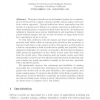Free Online Productivity Tools
i2Speak
i2Symbol
i2OCR
iTex2Img
iWeb2Print
iWeb2Shot
i2Type
iPdf2Split
iPdf2Merge
i2Bopomofo
i2Arabic
i2Style
i2Image
i2PDF
iLatex2Rtf
Sci2ools
AMFG
2007
IEEE
2007
IEEE
Model-Assisted 3D Face Reconstruction from Video
Abstract. This paper describes a model-assisted system for reconstruction of 3D faces from a single consumer quality camera using a structure from motion approach. Typical multi-view stereo approaches use the motion of a sparse set of features to compute camera pose followed by a dense matching step to compute the final object structure. Accurate pose estimation depends upon precise identification and matching of feature points between images, but due to lack of texture on large areas of the face, matching is prone to errors. To deal with outliers in both the sparse and dense matching stages, previous work either relies on a strong prior model for face geometry or imposes restrictions on the camera motion. Strong prior models result in a serious compromise in final reconstruction quality and typically bear a signature resemblance to a generic or mean face. Model-based techniques, while giving the appearance of face detail, in fact carry this detail over from the model prior. Face fe...
| Added | 02 Jun 2010 |
| Updated | 02 Jun 2010 |
| Type | Conference |
| Year | 2007 |
| Where | AMFG |
| Authors | Douglas Fidaleo, Gérard G. Medioni |
Comments (0)

